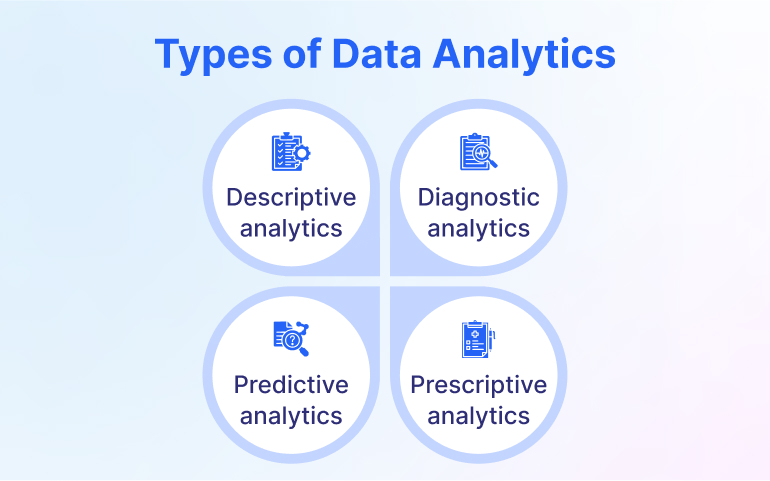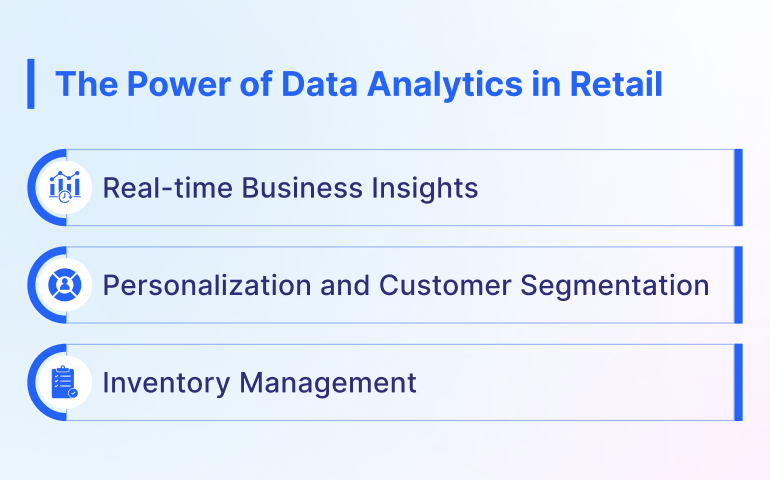Today’s retail landscape is complex, evolving rapidly due to technological advancements, changing consumer behaviors, and a competitive market. With online platforms gaining prominence, the industry faces a significant transformation.
Physical malls, once the cornerstone of retail, are being supplemented by digital spaces. Consumers’ increasing demand for convenience, variety, and personalization is leading retailers to embrace e-commerce, shaping a new retail reality beyond physical malls.
Retail Data analytics services have surged in importance as the industry grapples with these shifts. It gives retailers insights into customer behaviors, preferences, and trends, helping businesses adapt and thrive in this rapidly evolving landscape.
Understanding Data Analytics
Defining Data Analytics
Data analytics examines, cleans, transforms, and models data to discover useful information, draw conclusions, and support decision-making. In retail, data analytics aids in understanding consumers better, driving sales, and boosting customer satisfaction.
Data analytics involves various techniques and methods, which depend on the data’s nature and the analysis’s objectives. It can provide actionable insights that help shape the retail strategy, contributing to market expansion and sustained growth.
Types of Data Analytics
Data analytics can be broadly categorized into four types: descriptive, diagnostic, predictive, and prescriptive analytics.
Role of Data Analytics in the Retail Industry
Data analytics is pivotal in retail, offering numerous benefits that drive business growth.
- It provides insights into customer behavior and preferences, aiding in targeted marketing.
- It enables real-time inventory management, reducing overstock and stockouts.
- It allows for personalization, improving customer engagement and loyalty.
- It provides insights for business decisions, leading to improved efficiency and profitability.
- It offers predictive capabilities, helping businesses anticipate and prepare for future trends.
The Power of Data Analytics in Retail
Real-time Business Insights
Real-time data analytics helps retailers track their business operations and customer preferences. It provides immediate insights into sales trends, customer behaviors, and inventory levels, which aids in making prompt, informed decisions.
- It helps identify fast-moving items and slow sellers, guiding inventory decisions.
- It monitors customer behaviors and buying patterns, aiding in personalization.
- It tracks key performance indicators, informing business strategies.
- It offers a real-time view of the entire supply chain, highlighting areas for improvement.
Personalization and Customer Segmentation
With data analytics, retailers can personalize their offerings to match customer expectations and segment customers based on specific characteristics. This not only enhances customer satisfaction but also boosts brand loyalty.
- It enables product recommendations based on customer preferences and past purchases.
- It helps design targeted marketing campaigns for different customer segments.
- It aids in creating personalized shopping experiences and increasing customer engagement.
- It helps identify profitable customer segments to focus marketing efforts.
Inventory Management
Effective inventory management is critical for retail businesses. Data analytics provides insights into inventory levels, demand forecasts, and replenishment needs, ensuring optimal stock levels.
- It predicts demand for products, preventing overstock and understock situations.
- It identifies patterns in sales data to optimize inventory turnover.
- It offers real-time visibility into inventory levels across multiple locations.
- It enables automated restocking based on set thresholds.
Implementing Data Analytics in Retail: A Step-by-Step Guide
Identifying the Business Need
Before implementing data analytics, retailers must identify the business problems they aim to solve and the decisions they hope to inform with data.
- Define clear goals and objectives for the data analytics initiative.
- Identify the key performance indicators to monitor.
- Understand how data analytics can help address the business need.
Assembling the Right Team
Having the right team in place is critical for successful data analytics implementation.
- Include team members with various skills, including data science, business intelligence, and industry knowledge.
- Foster a culture that values data-driven decision-making.
- Consider outsourcing or partnering with data analytics firms if necessary.
Selecting the Right Data Analytics Tools
Choosing the right tools is key to effectively capture, analyze, and interpret data.
- Assess tools based on your specific business needs and the nature of your data.
- Consider scalability, ease of use, integration capabilities, and cost.
- Look for tools that offer real-time analytics, predictive capabilities, and data visualization.
Data Collection and Preparation
Collecting and preparing data is the next crucial step in data analytics.
- Identify the data sources, including point-of-sale systems, customer feedback, online traffic, social media, and more.
- Ensure data quality by cleaning and organizing the data. This may involve removing duplicates, filling in missing values, and correcting inconsistencies.
- Prepare the data for analysis by transforming it into a suitable format.
Analyzing Data and Generating Insights
Once the data is prepared, it’s time to analyze it and generate insights.
- Use suitable data analysis techniques based on your goals. This could involve statistical analysis, machine learning, predictive modeling, etc.
- Interpret the results to generate insights. Visual tools can help understand complex patterns and trends.
- Ensure these insights are actionable. They should inform decision-making and help address the identified business needs.
Case Studies: Success Stories of Data Analytics in Retail
Amazon: The Power of Recommendation Engines
Amazon’s recommendation engine is a prime example of data analytics in action. It uses customer data to suggest products a customer might like based on their browsing history and previous purchases. This personalized approach enhances customer experience and boosts sales.
Starbucks: Leveraging Location Data for Expansion
Starbucks utilizes data analytics to decide on new store locations. They analyze location, demographic, and customer behavior data to identify potential sites. This data-driven approach has been key in their successful expansion.
Walmart: Inventory Management through Data
Walmart leverages retail data analytics for real-time inventory management. By analyzing sales data, they can predict demand and automate restocking. This has significantly reduced out-of-stock scenarios, improving customer satisfaction and sales.
Our Case Study: From Churn To Retention: GetOnData’s Data-Driven Approach For A Retail Company
Overcoming Challenges in Data Analytics Implementation
Data Privacy and Security
Data privacy and security are significant concerns when implementing data analytics. Retailers must ensure they protect sensitive customer data and comply with relevant regulations.
- Implement robust data security measures to protect against data breaches.
- Ensure compliance with data protection regulations like GDPR.
- Inform customers about how their data is used and safeguarded.
Data Quality and Management
Data quality and effective data management are crucial for reliable analytics.
- Regularly clean and update data to ensure accuracy.
- Implement effective data governance strategies to manage data assets.
- Use tools and techniques to handle large volumes of data (big data).
Skill Gap and Staff Training
A skill gap can be a barrier to successful data analytics implementation. Staff training can help address this.
- Invest in training to help staff develop data literacy and analytics skills.
- Hire data science professionals or partner with analytics firms, if necessary.
- Foster a culture that values data-driven decision-making.
Looking Forward: The Future of Data Analytics in Retail
Emerging Trends in Retail Analytics
Emerging trends in retail analytics promise to further revolutionize the retail industry.
- Predictive analytics is becoming more accurate and granular, thanks to machine learning.
- Real-time analytics are gaining prominence, offering up-to-the-minute insights.
- Augmented analytics, which uses AI to automate data insights, is rising.
How Data Analytics Can Help in Sustainable Growth
Data analytics plays a critical role in achieving sustainable growth in retail.
- It helps optimize resources, reducing waste and promoting sustainability.
- It aids in building lasting relationships with customers, ensuring repeat business.
- It provides insights for strategic planning, helping businesses adapt to market changes.
Anticipating Future Challenges
While data analytics offers numerous benefits, it’s also important to anticipate potential challenges.
- Rapidly evolving technology may render current data analytics tools and techniques obsolete.
- As data volume grows, so does the challenge of effectively managing and analyzing it.
- Ensuring data privacy and security will become increasingly complex as more customer data is collected.
Conclusion
Data analytics has revolutionized the retail industry, offering insights that aid decision-making, enhance customer experience, and optimize operations. Successful implementation requires clear goals, the right team, suitable tools, effective data management, and continuous learning and adaptation.
Embracing data analytics services in retail is no longer optional—it’s essential for staying competitive in the digital age. As we look to the future, the role of data analytics in retail is set to grow, shaping the industry in new and exciting ways.
FAQs
1. What is the first step in implementing data analytics in retail?
The first step is identifying the business needs that data analytics can address. This involves setting clear goals and defining key performance indicators.
2. How can a small retailer benefit from data analytics?
Even small retailers can use data analytics to understand their customers better, optimize their operations, and make informed decisions. This can improve customer satisfaction, increase sales, and greater efficiency.
3. Are there risks involved in relying heavily on data analytics?
While data analytics offers numerous benefits, it’s important to be aware of potential risks, such as data breaches and privacy concerns. Retailers must implement robust data security measures and ensure compliance with data protection regulations.
4. What measures can retailers take to ensure data privacy and security?
Retailers should implement strong data security measures, ensure compliance with data protection laws, and be transparent with customers about how their data is used and protected.
5. How is the role of data analytics expected to evolve in the retail industry in the future?
Data analytics will likely become more sophisticated and integrated into retail operations as technology advances. Emerging trends like predictive, real-time, and augmented analytics are set to further revolutionize the industry.

